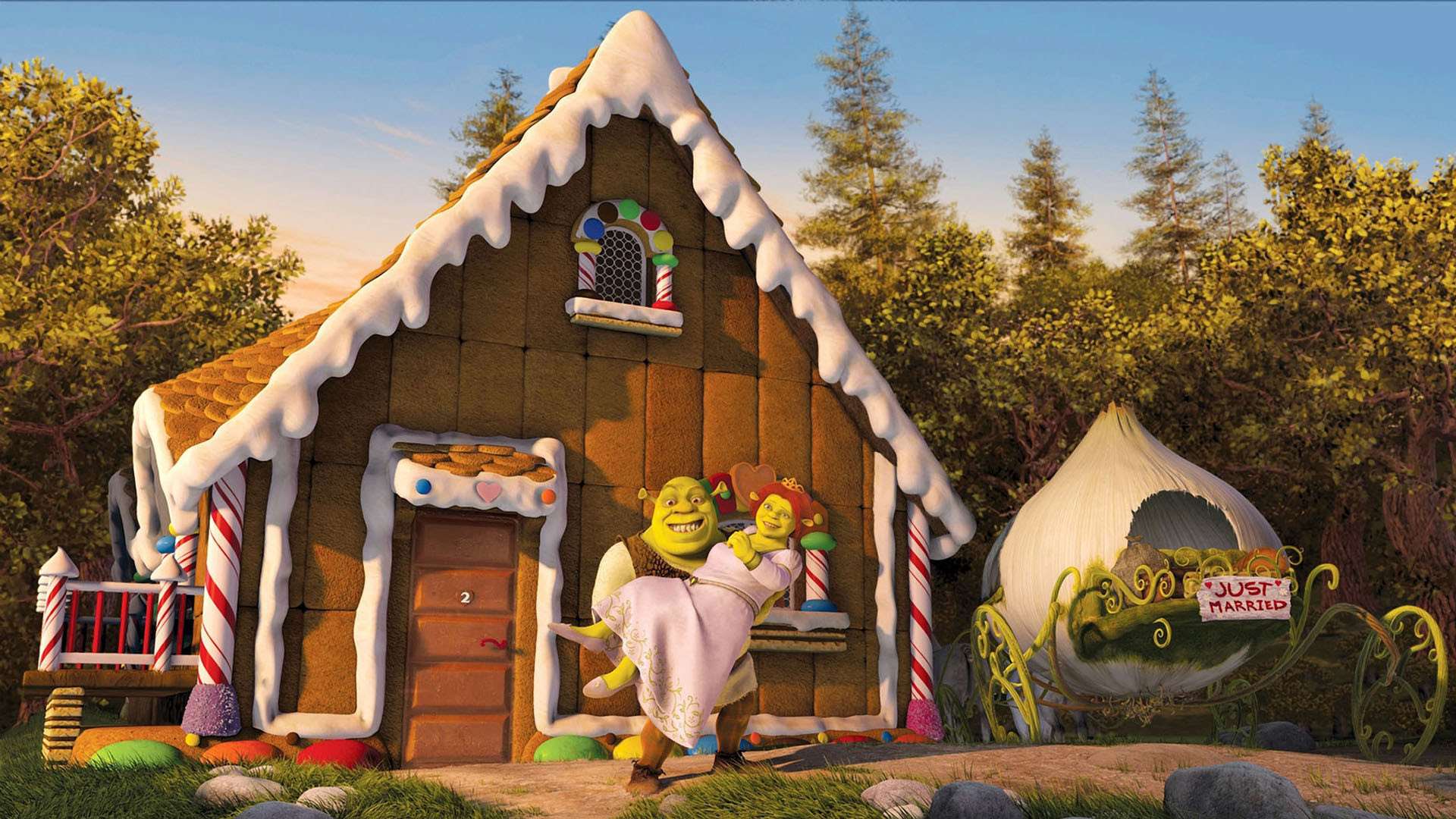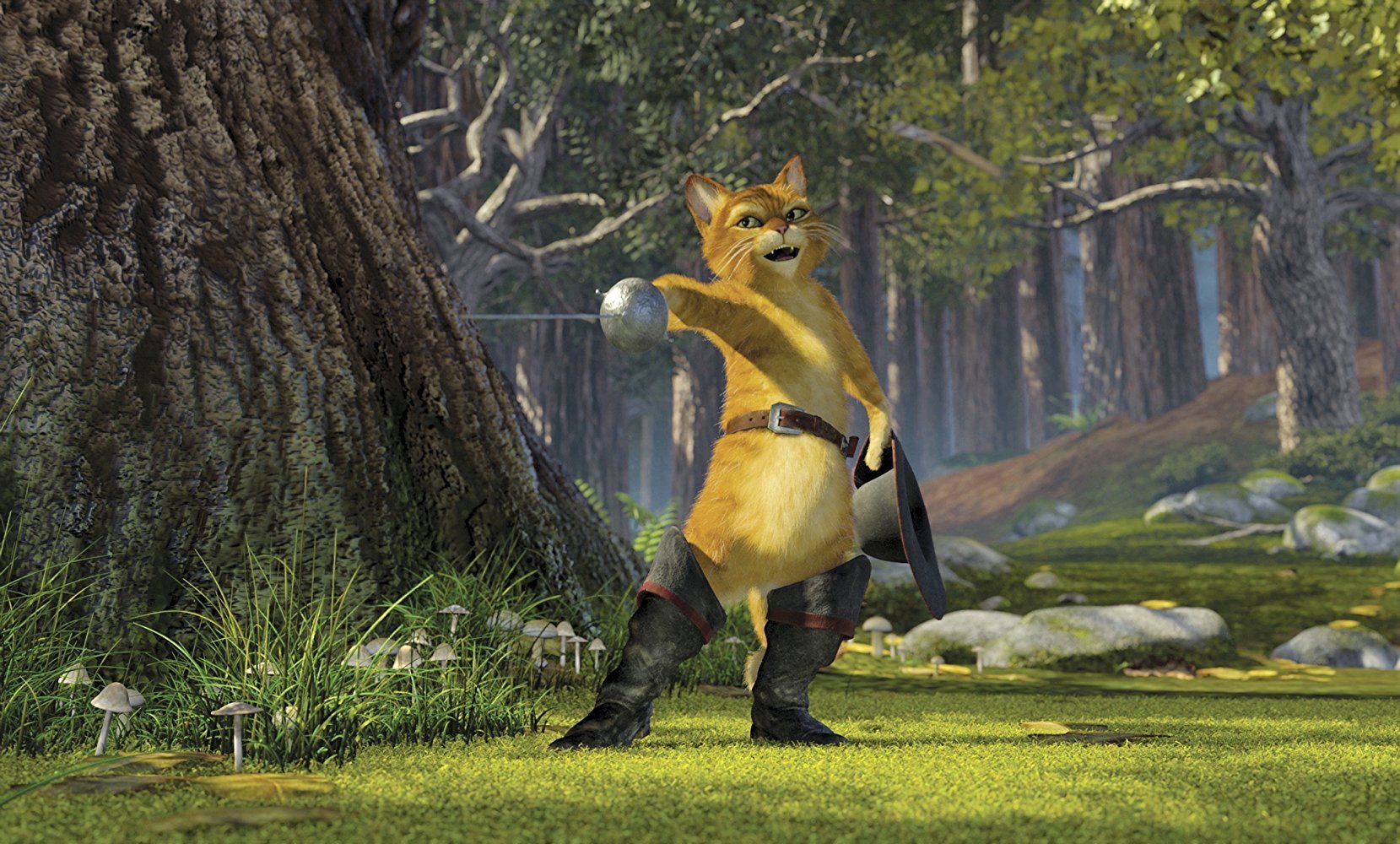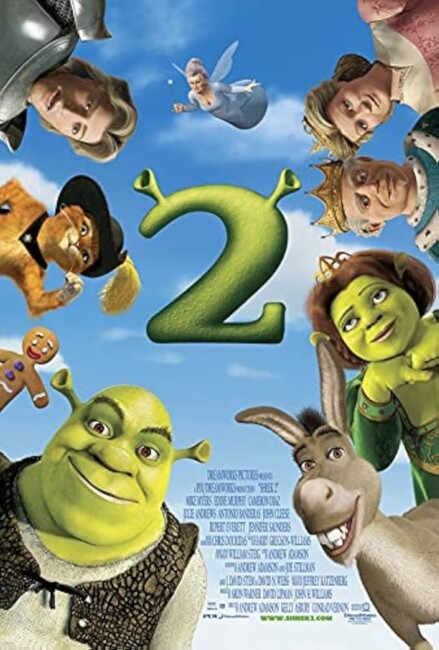Crew
Directors – Andrew Adamson, Kelly Asbury & Conrad Vernon, Screenplay – J. David Stem, Joe Stillman & David N. Weiss, Story – Andrew Adamson, Producers – David Lipman, Aron Warner & John H. Williams, Music – Harry Gregson-Williams, Music Supervisor – Chris Douridas, Animation Supervisors – James Baxter, Tim Cheung & Raman Hui, Visual Effects Supervisor – Rick Bielenberg, Production Design – Guillaume Aretos. Production Company – PDI/DreamWorks SKG.
Voices
Mike Myers (Shrek), Cameron Diaz (Princess Fiona), Eddie Murphy (Donkey), Antonio Banderas (Puss in Boots), John Cleese (King Harold), Jennifer Saunders (Fairy Godmother), Julie Andrews (Queen Lillian), Rupert Everett (Prince Charming), Cody Cameron (Pinocchio/The Three Pigs), Conrad Vernon (Gingerbread Man/Cedric/Announcer/Muffin Man/Mongo), Larry King (Ugly Stepsister), Christopher Knights (Blind Mouse)
Plot
Returning back home with Fiona after his honeymoon, Shrek is reluctantly persuaded to travel to Far Far Away Land to meet Fiona’s parents. The meeting does not go happily on either part, with they being shocked at Shrek’s ogre appearance. Fiona’s father King Harold is then approached by the Fairy Godmother who reminds him that Fiona was meant to marry her son Prince Charming. The Fairy Godmother wants Harold to eliminate Shrek so that this union can now go ahead. Harold hires the services of the cat assassin Puss in Boots. Instead, Shrek overcomes and wins the loyalty of Puss in Boots. Believing that Fiona does not desire him as an ogre, Shrek, Puss and the donkey break into the Fairy Godmother’s potion factory and steal some of her Happy Ever After formula. Shrek takes it and is transformed into a handsome, brawny human but needs to win Fiona’s kiss before midnight for the change to become permanent. After realising what Shrek has done, the Fairy Godmother conspires to pass Charming off as the transformed Shrek and marry him to Fiona without her realising.
Audiences everywhere, adult and child, critics and amateurs, loved Shrek (2001) – one has yet to read a bad word written about it. The film had a naturalistically warm and off-the-wall sense of humour and frequently punctured the seriousness of fairytales, all of which endeared itself enormously to audiences and made Shrek a big hit. Shrek won the first of the newly instituted Academy Awards for Best Animated Feature in 2002. Shrek 2 was the first of three sequels greenlit by DreamWorks.
Shrek 2 was generally granted the same glowingly positive reception that the original received and opened to great box-office success. I must admit, while I was expecting to enjoy Shrek 2, my response was a good deal less enthusiastic. It feels like a lesser sequel. The first Shrek had a clearcut character arc – that of a classic fairytale quest story, which it wittily subverted by playing everything against expectation.
By contrast, all that Shrek 2 does is to pump up the element of fairytale parody and coast by on the familiarity of the characters and humour. What seems to be crucially lacking is the freshness that the original had. The familiar characters seem muted this time around – Shrek is no longer a grumpy ogre but spends most of the film mooning about in love; Fiona is not given much to do; while Eddie Murphy launches into the same smartass ingratiating donkey character but only gives us more of what we have seen before.

The most engaging of the new characters is Antonio Banderas’s Puss in Boots who seems to have been modelled on Mandy Patinkin’s Spanish swordsman in The Princess Bride (1987). Puss in Boots fairly much steals the show – he has a particularly appealing move where he charms opponents by mooning his eyes at them – but even then his character arc is poorly defined – the scene where he swaps over from assassin to loyal follower of Shrek comes with amazingly little motivation and decision.
It is a similar case with other plot points – the quest story is perpetually being subverted by flashy action/humour sequences – a break-in to the Fairy Godmother’s factory to steal the potion; a big climactic sequence rushing to save Fiona from the marriage with all of the characters getting into the action amid animated acrobatics; even a gratuitously motivated jailbreak sequence. There is a plot connecting this but on many of these occasions the connecting points between sequences are slim.
In Shrek, the fairytale parody and contemporary culture reference played around the sides of the film with an acceptable sense of humour but Shrek 2 has irritatingly bumped this to centre stage. Personally, I hate fantasy films that are constantly twisting everything around to make contemporary culture jokes. It ruptures the suspension of disbelief to have characters in fantasy realms referring to contemporary tv shows, celebrities and pop culture. It is a pandering to lowest audience common denominator – making everything familiar to the audiences in the here and now and is certainly something that guarantees Shrek 2 a lack of shelf life beyond passing interests of the moment. Try to imagine J.R.R. Tolkien deciding he could make The Lord of the Rings (1954-6) more sellable if he were to have hobbits and elves cracking jokes about post-War shortages or doing parodies of celebrities of the day.

In Shrek 2, we get gags about Far Far Away Land being a parody of Beverly Hills replete with fantasy equivalents of brand-name places like Starbucks and Versace’s and where every fairytale princess lives behind a gated mansion; the Fairy Godmother’s crystal ball has its own answer phone; there is a parody of the tv show Cops (1989– ) called Knights; the pending wedding ceremony is like a Hollywood gala premiere and so on. It seems vaguely amusing but fails to rouse a laugh particularly often.
Similarly, familiar fairytale characters make various comic appearances – the most amusing of these is when Pinocchio, the Three Blind Mice and the Gingerbread Man conduct a jailbreak by lowering Pinocchio on his wires and getting him to bridge the gap by making his nose extend when he denies that he is wearing a thong. (There is an adorable sequence after the end credits have started to roll where we meet the donkey and the dragon’s kids). Alas, Shrek 2 feels more like one of the endless video sequels that Disney are continually turning out to their classic product – a routine effort where all the freshness that the original had has been buried under formula.
Shrek 2 was followed by Shrek the Third (2007) and Shrek Forever After (2010). Puss in Boots was granted his own film with Puss in Boots (2011).
(No. 1 on the SF, Horror & Fantasy Box-Office Top 10 of 2004 list).
Trailer here


